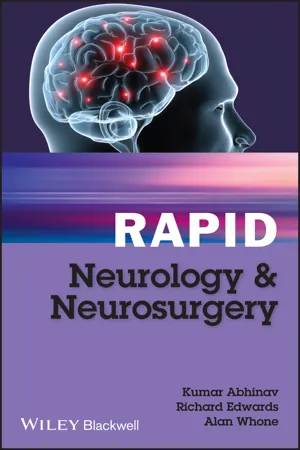
- English
- ePUB (mobile friendly)
- Available on iOS & Android
Rapid Neurology and Neurosurgery
About This Book
RAPID Neurology & Neurosurgery
The Rapids are a series of two-colour reference and revision pocket books that cover key facts in a simple and memorable way. Each book covers the common conditions or drugs that students and junior doctors encounter on the wards, in clinics, and in their exams. The core relevant facts are provided to ensure these books are perfect concise 'rapid refreshers'. To see all titles in the series, go to: www.wiley.com/go/rapids
Rapid Neurology and Neurosurgery is a must for all medical students and junior doctors-it is a quick and easy on-the-ward or clinical reference and the perfect revision tool for those approaching finals, undergraduate neurology and neurosurgery examinations and the Membership of Royal College of Surgeons (MRCS) examinations.
It provides a concise, structured approach to neurology and neurosurgery learning, covering key fact in a simple and memorable way:
PART I (The Basics) features the basic principles and facts essential for a good understanding of neurology and neurosurgery and includes sections on relevant neuroanatomy, neurological history and examination, and investigation including neurophysiology and neuroradiology. MRI and CT scans are included throughout the text.
PART II (Complaints: Face-to-Face with the patient) features OSCE-style and viva-voce examination preparation and has chapters on presenting complaints, with relevant and selected questions to ask for establishing the differential diagnoses (presented in a table) with basic investigations and management.
PART III (Conditions: Applying the basics) presents important clinical conditions with sections on definition, epidemiology, aetiology, associations/risk factors, pathology, history, examination, investigations, management, complications, prognosis and a list of differential diagnoses with general clinical information and distinguishing information to exclude the alternative diagnoses.
Each chapter includes key points to remember and highlights key facts.
Rapid Neurology and Neurosurgery contains only the essential, core, and relevant facts in a concise, pocket-sized, 'rapid' refresher-providing a thorough foundation of neurology and neurosurgery knowledge that will allow you to excel in the examinations.
All content reviewed by students for students
Wiley-Blackwell Medical Education books are designed exactly for their intended audience. All of books are developed in collaboration with students. This means that our books are always published with you, the student, in mind. If you would like to be one of our student reviewers, go to www.reviewmedicalbooks.com to find out more. To receive automatic updates on Wiley-Blackwell books and journals, join our email list. Sign up today at www.wiley.com/email
Frequently asked questions
Information
Cortical Anatomy

- Primary motor cortex: Situated anterior to central sulcus (frontal lobe) in the precentral gyrus; involved in contralateral motor function—Brodmann's (Br.) Area 4.
- Primary somatosensory cortex: Situated posterior to central sulcus (parietal lobe) in the postcentral gyrus; involved in contralateral sensory function—Br. Areas 1, 2 and 3.
- Motor speech area: In the dominant hemisphere only (left hemisphere for right-handed subjects and usually left hemisphere for left-handed people); anatomically situated in the inferior frontal gyrus (pars triangularis and opercularis); also known as ‘Broca's area’ and involved in speech output—Br. Area 44.
- Wernicke's area: In the dominant hemisphere; anatomically situated in the supramarginal gyrus—Br. Area 40 (part of inferior parietal l...
Table of contents
- Cover
- Title Page
- Copyright
- List of Abbreviations
- Preface
- Acknowledgements
- Part I: The Basics
- Part II: Complaints: Face-to-Face with the Patient
- Part III: Conditions: Applying the Basics
- Appendices
- Index